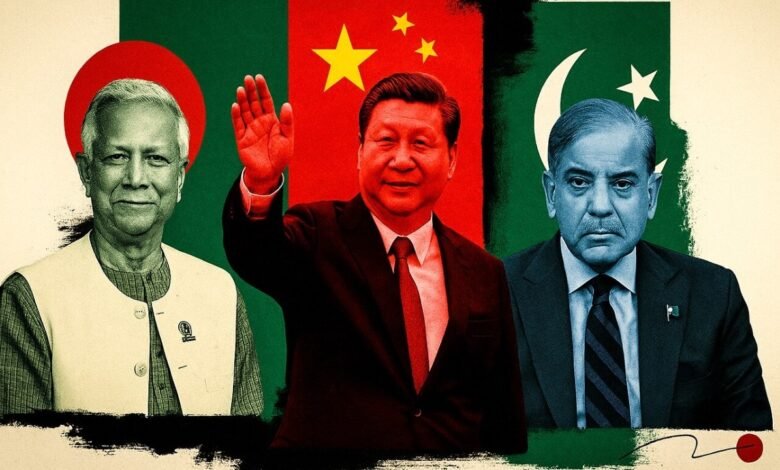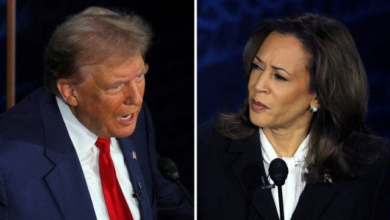Concern for India as debt diplomacy sees Bangladesh, Pakistan converge with China

Concern for India as debt diplomacy sees Bangladesh, Pakistan converge with China
Through its debt diplomacy, China has turned Pakistan into a vassal state. It is attempting the same in Bangladesh, whose economy and political stability, particularly after the ouster of Prime Minister Sheikh Hasina, are in the doldrums. While Pakistan has seen just Chinese intrusion, Bangladesh is witnessing a convergence of forces and interests inimical to India. The possible convergence of China, Pakistan and Bangladesh in India’s strategic backyard has emerged as a major concern for New Delhi, which Chief of Defence Staff General Anil Chauhan flagged recently.
The most recent example of the convergence of interests would be the meeting of representatives from Pakistan, Bangladesh and China for an alternative to the Saarc, a grouping in which India played a key role. The Saarc has been inactive since the 2016 Uri attack by Pakistani terrorists. Representatives of the three countries met in China’s Kunming on June 19 on the Saarc alternative.
China has been working for years to spread its tentacles in the Indian subcontinent. In Pakistan and Bangladesh, China’s arms deals and loans have deeply rooted its influence, aligning their interests with Beijing.
Then there is Turkey, which provided military support to Pakistan during its days-long conflict with India during Operation Sindoor, is deepening its defence engagement with Bangladesh, and is seeking favourable real estate for arms manufacturing.
Amid the possibility of a China-led nexus, and with Turkey acting as a common denominator between India’s western and eastern neighbours, New Delhi could be entering tricky diplomatic terrain.
At first glance, the tensions between India and Bangladesh, and between India and Pakistan, appear to be bilateral disputes. But just scratching the surface reveals China’s fingerprints.
Take Pakistan, for instance – a state that is little more than a borrower of loans and purchaser of weapons. Its economy leans heavily on IMF assistance and loans from China, while over 80% of its military hardware comes from China.
The World Bank estimates Pakistan’s debt repayments to China could stretch over 40 years. And Beijing is all too willing to tighten this leash on Islamabad for its dominance in South Asia.
China was even allegedly also involved in the mini-war between India and Pakistan in May 2025. Indian Army Deputy Chief Lt Gen Rahul R Singh had alleged that Beijing offered active military support to Pakistan during Operation Sindoor – an assertion China denied.
Some observers even described the war as a live testing ground for Chinese weaponry.
Beijing has also tried to defame a fighter jet supplier to India.
On the other hand, India’s eastern neighbour, Bangladesh, is also showing signs of being sucked into China’s debt trap, more so after student-led protests dislodged Hasina’s government in August 2024. The interim government led by Muhammad Yunus has shown enough signs of its willingness to join the Chinese camp.
Since Hasina’s ouster, Bangladesh has been facing growing economic fragility. Hasina’s choice of India for her self-imposed exile has also strained Dhaka’s ties with New Delhi.
Such shrewd regional politics, coupled with China’s growing influence over both Pakistan and Bangladesh, is a concerning scenario for India.
HOW CHINA AND PAKISTAN ARE CONVERGING IN BANGLADESH
While Pakistan has seen Chinese intervention through infrastructure projects, Bangladesh is also leaning closer to Pakistan even as it entangles itself in loans from China.
The toppling of Sheikh Hasina’s regime on August 5, 2024, created a ground that was perfect for the breeding of this convergence.
A June 2025 Chatham House survey indicated that 75% of Bangladeshis view China favourably, compared to just 11% for India.
There has been extensive propaganda in the last couple of years that India was propping up the Hasina regime, which was infamous for its authoritarian nature. The anti-Hasina sentiments might have rubbed off on India.
The interim government of Muhammad Yunus is cosying up to Pakistan.
The most noticeable has been the military engagements between the two countries despite the bloody history of the Pakistani army in Bangladesh.
The Bangladesh Navy participated in Aman 2025, a naval exercise in Karachi, after a gap of 12 years. Earlier in January, a high-level Bangladeshi military delegation held talks with Pakistan Army chief Field Marshal Asim Munir.
Bangladesh and Pakistan have also established trade ties.
The two countries resumed direct trade in February 2025 for the first time since 1971, when Bangladesh (then East Pakistan) gained liberation from West Pakistan.
An agreement signed in February will see Bangladesh purchasing 50,000 tonnes of Pakistani rice.
While the Yunus government is bonding with Pakistan, it is allowing China to gain a firmer grip.
That’s a diversion from the past when Hasina smartly balanced Indian and Chinese interests.
China has capitalised big time on Bangladesh’s economic vulnerability to expand its footprint in South Asia.
Economically, China, through its tried and tested debt diplomacy, exploits vulnerabilities across the world, and also in the Indian Ocean Region, which New Delhi considers its strategic backyard.
China’s loans to Bangladesh are estimated at $6.1 billion, according to a 2023 AidData report. The loans are primarily for Belt and Road Initiative (BRI) projects such as the Padma Bridge, the construction of the Payra Port, and coal-fired power plants. For a developing country whose economy is in tatters, these loans are massive.
This comes amid the fact that China is the fourth-largest source of foreign loans in Bangladesh, according to a report by the Dhaka-based Prothom Alo.
In March this year, China lent $2.1 billion to Bangladesh. Even before Hasina’s ouster, in 2024, Bangladesh had sought a $5 billion soft loan from China to ease pressure on its dollar reserves, but the finalisation remains unconfirmed.
However, Reuters reported earlier this year that China would consider Bangladesh’s requests to lower interest rates on Chinese loans, and it did. China extended repayment terms from 20 years to 30 years, easing immediate pressure on Bangladesh, reported the Dhaka-based Daily Star.
CHINA-PAK-BANGLADESH NEXUS HAS A MEMBER FROM WEST ASIA
Amid the geopolitical tussle among South Asian neighbours, a West Asian player is stirring the situation too.
Turkey’s deepening engagement with Bangladesh adds a fresh layer to India’s concerns.
In July 2025, Haluk Gorgun, the chief of Ankara’s defence industries, held talks with Yunus, aiming to establish defence industrial zones in Chittagong and Narayanganj, building on earlier drone exports to Dhaka.
This military outreach, combined with the Turkish Cooperation and Coordination Agency’s humanitarian aid for Rohingya refugees in Bangladesh and growing trade engagements, signal a broader alignment in the nexus with Pakistan and China.
While Turkey’s economic ties with Bangladesh remain modest, its growing footprint on India’s eastern borders must be an uncomfortable reality for New Delhi.
Even without Turkey, the convergence of China, Pakistan and Bangladesh interests would be concerning for India.
“There is a possible convergence of interests we can talk about between China, Pakistan, and Bangladesh that may have implications for India’s stability and security dynamics,” CDS General Chauhan said at the ORF event, according to a report in The Indian Express.
Chauhan, according to a PTI report, blamed the economic distress in these countries for allowing “outside powers” to leverage their influence, which could “create vulnerabilities for India”.
India is faced with a new reality in its neighbourhood. While the western front was always a concern, the eastern front has now become a playground for forces that aren’t on friendly terms with it.
– Ends
Tune In
Source link



